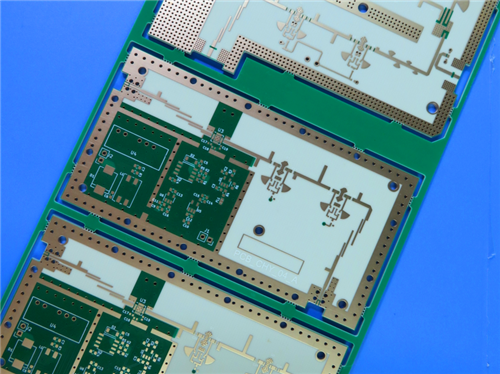Multilayer Stackup Design: Minimizing Crosstalk in High-Speed PCBs
Introduction
In high-speed PCB design, signal integrity is paramount. As data rates increase, crosstalk—unwanted electromagnetic coupling between traces—becomes a critical challenge. A well-optimized multilayer stackup is essential to minimize crosstalk while ensuring signal integrity, power delivery, and manufacturability.
This article explores how to design a 6-layer PCB stackup for high-speed applications, using our RO4350B + S1000-2M construction as a case study. We’ll examine material selection, layer arrangement, impedance control, and design techniques to reduce crosstalk.
Understanding Crosstalk in High-Speed PCBs
Crosstalk occurs when signals on adjacent traces interfere due to capacitive (electric field) and inductive (magnetic field) coupling. Key factors influencing crosstalk include:
-
Trace spacing & parallelism–Closer traces increase coupling.
-
Reference plane proximity–A solid ground plane reduces interference.
-
Signal layer arrangement–Poor stackup design exacerbates crosstalk.
-
Dielectric material properties–Lower Dk and Df materials help reduce coupling.
A well-designed 6-layer hybrid PCB stackup can mitigate these issues by providing:
✔Shielded signal layers
✔Controlled impedance routing
✔Optimized dielectric spacing
Case Study: 6-Layer High-Speed PCB Stackup
Our 6-layer PCB (76.5mm x 83mm) is designed for high-speed applications with RO4350B microwave laminate and S1000-2M high-Tg FR4.
PCB Stackup Breakdown
|
Layer
|
Material
|
Thickness
|
Function
|
|
L1
|
Copper (35μm)
|
-
|
Signal (Top Layer, 50Ω impedance)
|
|
PP1
|
RO4350B
|
0.254mm
|
Low-loss dielectric
|
|
L2
|
Copper (35μm)
|
-
|
Ground Plane
|
|
PP2
|
Prepreg (1080)
|
0.127mm
|
Bonding layer
|
|
L3
|
Copper (35μm)
|
-
|
Signal (Internal High-Speed)
|
|
Core
|
S1000-2M
|
0.254mm
|
High-Tg FR4 for stability
|
|
L4
|
Copper (35μm)
|
-
|
Power Plane
|
|
PP3
|
Prepreg (1080)
|
0.127mm
|
Bonding layer
|
|
L5
|
Copper (35μm)
|
-
|
Signal (Internal High-Speed)
|
|
PP4
|
RO4350B
|
0.254mm
|
Low-loss dielectric
|
|
L6
|
Copper (35μm)
|
-
|
Signal (Bottom Layer, 50Ω impedance)
|

Key Features for Crosstalk Reduction
1. Rogers RO4350B for Critical Signal Layers
-
Low Dk (3.48) & Df (0.0037) minimizes signal loss and coupling.
-
CTE-matched to copper prevents via reliability issues.
2. ShengyiS1000-2M Core for Mechanical Stability
-
High Tg (180°C) & low Z-CTE ensures thermal reliability.
-
Anti-CAF performance prevents conductive anodic filamentation.
3.Impedance Control (50Ωon Top Layer)
-
4mil trace width with ENIG finish ensures consistent impedance.
4.Shielding with Ground & Power Planes
-
L2 (Ground) & L4 (Power) isolate high-speed signals (L1, L3, L5, L6).
5.Blind Vias (L1-L2) for Signal Integrity
-
Reduces stub effects in high-speed signal transitions.
Design Techniques to Minimize Crosstalk
1. 3W Rule for Trace Spacing
Keep spacing≥3x trace width (e.g., 12mil spacing for 4mil traces).
2. Differential Pair Routing
Maintain consistent spacing & length matching to reduce EMI.
3. Avoid Parallel Routing on Adjacent Layers
Orthogonal routing (90°angles) reduces capacitive coupling.
4. Use Ground-Filled Areas Between Signals
Additional copper pours act as shields.
5. Controlled Dielectric Thickness
Thinner prepreg (0.127mm) reduces crosstalk between layers.
Why This Stackup Works for High-Speed Designs?
✅Low-Loss Materials (RO4350B)→Better signal integrity at GHz frequencies.
✅Solid Ground/Power Planes→Shields high-speed signals.
✅Blind Vias & Impedance Control→Minimizes reflections & EMI.
✅Thermally Stable Core (S1000-2M)→Ensures reliability in harsh conditions.
Applications of This PCB Design
-
5G & Millimeter-Wave Circuits
-
Radar & Satellite Communication Systems
-
High-Speed Digital Boards (FPGA, DDR4/5)
-
RF Antennas & Microwave Circuits
Conclusion
A well-optimized multilayer stackup is critical for minimizing crosstalk inhigh-speed PCBs. By using low-loss materials (RO4350B), proper shielding, and controlled impedance routing, this 6-layer hybrid circuit board design ensures signal integrity while meeting IPC-Class-2 standards.
For high-frequency, high-speed, or RF applications, our RO4350B + S1000-2M stackup provides an ideal balance of performance, reliability, and cost-effectiveness.
Need a custom high-speed PCB solution? Contact us today for expert design and manufacturing support!

 Call Us Now !
Tel : +86 755 27374946
Call Us Now !
Tel : +86 755 27374946
 Order Online Now !
Email : info@bichengpcb.com
Order Online Now !
Email : info@bichengpcb.com














